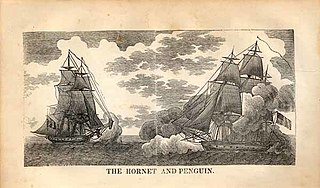
The first USS Essex of the United States Navy was a 36-gun or 32-gun sailing frigate that participated in the Quasi-War with France, the First Barbary War, and in the War of 1812. The British captured her in 1814 and she then served as HMS Essex until sold at public auction on 6 June 1837.
USS Growler was a 112-ton sloop-of-war, armed with ten 18-pounders and one 6-pounder, during the War of 1812. The United States Navy purchased Growler on Lake Champlain in 1812. The British captured her in 1813 and renamed her HMS Chub or Chubb. The Americans recaptured her at the Battle of Lake Champlain. She was sold in 1815.

USS Wasp of the United States Navy was a sailing sloop-of-war captured by the British in the early months of the War of 1812. She was constructed in 1806 at the Washington Navy Yard, was commissioned sometime in 1807, Master Commandant John Smith in command. In 1812 she captured HMS Frolic, but was immediately herself captured. The British took her into service first as HMS Loup Cervier and then as HMS Peacock. She was lost, presumed foundered with all hands, in mid-1814.

HMS Confiance was a 36-gun fifth-rate frigate that served in the Royal Navy on Lake Champlain during the War of 1812. Confiance served as Captain George Downie's flagship at the Battle of Plattsburgh, on 11 September 1814. Surrendered to the American Squadron following a nearly 2½ hour battle, she was eventually taken to Whitehall, New York where she was taken into the U.S. Navy and placed in ordinary. The vessel was formally abandoned by the Navy in 1820 and after being partially salvaged, was allowed to sink at her moorings. As a danger to navigation, the sunken hulk was destroyed with dynamite charges during dredging operations on the channel in 1873.
HMS Chippawa, or Chippeway, was the mercantile schooner Chippawa, built and launched in 1810. The British brought her into service as HM Schooner Chippawa, sometimes recorded as Chippeway.

HMS St Lawrence was a 14-gun schooner of the Royal Navy. She had been built in 1808 in St. Michaels, Talbot County, Maryland for Thomas Tennant and sold to Philadelphians in 1810. During the War of 1812 she was the US privateer Atlas. The UK captured her in 1813 and renamed her St Lawrence. The US privateer Chasseur recaptured her in 1815, and then HMS Acasta re-recaptured her.
Ten ships of the Royal Navy have borne the name HMS Confiance:

HMS Manly was a 12-gun Bold-class gun-brig of the Royal Navy, launched in 1812. She served in the War of 1812, her boats participating in the Battle of Lake Borgne. She was sold in 1833.
HMS Cydnus was one of eight Royal Navy 38-gun Cydnus-class fifth-rates. This frigate was built in 1813 at Blackwall Yard, London, and broken up in 1816.
Three ships of the Royal Navy have borne the name HMS Chub, or alternatively HMS Chubb, a name given to several types of fish, many in the family Cyprinidae:

HMS Penguin was a Royal Navy Cruizer-class brig-sloop launched in 1813. In 1815 USS Hornet captured Penguin in a battle that took place after the end of the War of 1812. Hornet then scuttled Penguin as she was too damaged to merit keeping.
During the period of the French Revolutionary and Napoleonic Wars, there were two or three vessels known as His Majesty's hired armed cutter Active that served the British Royal Navy. The reason for the uncertainty in the number is that the size of the vessels raises the possibility that the first and second may have been the same vessel.

HMS Carron was a 20-gun Cyrus-class sixth-rate post ship of the Royal Navy built in 1813 by Edward Adams, at Bucklers Hard in Hampshire. She was wrecked in 1820.

HMS Peacock was a Cruizer-class brig-sloop of the Royal Navy. She was launched in 1806 and had a relatively uneventful career until she had the misfortune to encounter USS Hornet in February 1813. Hornet captured Peacock, which then sank.
HMS Pultusk was the American-built French privateer sloop Austerlitz, which had been launched in 1805 and which the Royal Navy captured in 1807 and took into service as HMS Pultusk. Pultusk served in three campaigns, two of which resulted, some four decades later, in the award of medals, and one boat action that too received a medal. She was broken up in 1810.
HMS Vautour was 16-gun brig-sloop of the British Royal Navy. The navy captured her from the French on the stocks in 1809 and commissioned her in 1810. She foundered in October 1813.
HMS Elizabeth was a French privateer schooner that the Royal Navy captured in 1805 and took into service under her existing name. She participated in an engagement and a campaign that earned her crews clasps to the Naval General Service Medal. She was lost with all hands in 1814 when she capsized in the West Indies.
HMS Express was the American merchant vessel Achilles, launched in 1809 in America. Her owners in 1813 renamed her Anna Maria. In 1814 she served the British Royal Navy in North American waters as an advice boat. In 1815 the Royal Navy commissioned her as HMS Express, a ship's tender serving in the Mediterranean. In 1816 she was at the bombardment of Algiers. The Navy sold her at Malta in 1827.
HMS Nymphe was a 38-gun fifth rate frigate of the Royal Navy, launched on 13 April 1812 at Woolwich Dockyard, and commissioned later that month. She was a Lively class of 18-pounder frigates, designed by the Surveyor of the Navy, Sir William Rule. It was probably the most successful British frigate design of the Napoleonic Wars, to which fifteen more sister ships would be ordered between 1803 and 1812.








